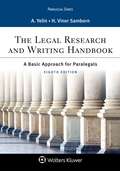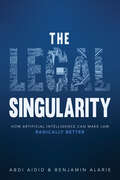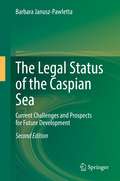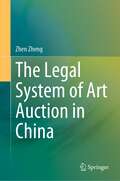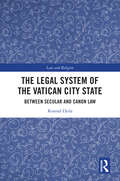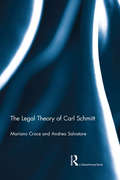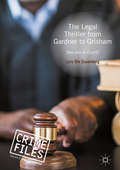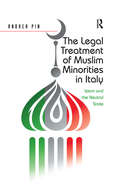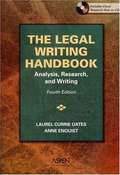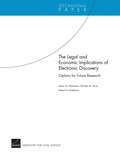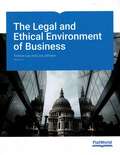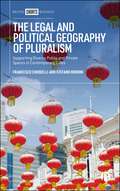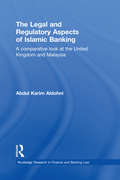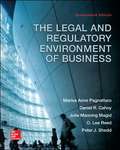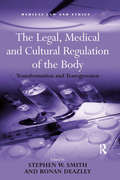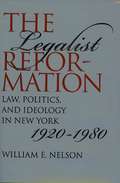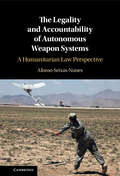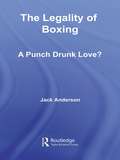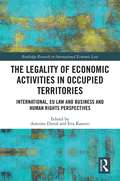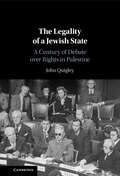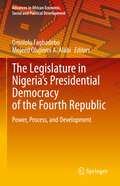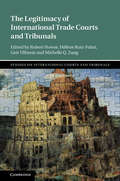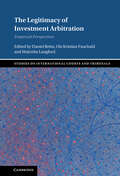- Table View
- List View
The Legal Research and Writing Handbook: A Basic Approach for Paralegals (Aspen Paralegal)
by Andrea B. Yelin Hope Viner SambornWith clear explanations, examples, and visual aids, The Legal Research and Writing Handbook, Eighth Edition by Andrea Yelin and Hope Viner Samborn offers complete coverage of a complex subject in a student-friendly, accessible text. In this thoroughly updated new edition, the authors continue to keep pace with legal research, citation, and technology in today’s law firms. This practical text focuses on efficient research processes and techniques for both traditional and electronic sources, along with step-by-step instruction through each stage of the legal writing process, from prewriting strategies, to revising. The text is enhanced with examples and visual aids, expert writing and practice tips, hands-on exercises, ethics alerts, up-to-date web resources, and easy-to-navigate page design. Excellent exercises are provided to reinforce student learning. <P><P> Key Features: <li>Updated and expanded coverage of electronic resources reflecting how paralegals do research today <li>Detailed discussion of how to use legal authorities in legal communications and how to synthesize them and present them to attorneys <li>Examples, exhibits, practical tips, updated exercises, and web resources in every chapter <li>Expanded discussion of e-mail and e-memos <li>In-depth coverage of the IRAC method, as well as how to write legal memoranda and legal correspondence
The Legal Singularity: How Artificial Intelligence Can Make Law Radically Better
by Benjamin Alarie Abdi AididLaw today is incomplete, inaccessible, unclear, underdeveloped, and often perplexing to those whom it affects. In The Legal Singularity, Abdi Aidid and Benjamin Alarie argue that the proliferation of artificial intelligence–enabled technology – and specifically the advent of legal prediction – is on the verge of radically reconfiguring the law, our institutions, and our society for the better. Revealing the ways in which our legal institutions underperform and are expensive to administer, the book highlights the negative social consequences associated with our legal status quo. Given the infirmities of the current state of the law and our legal institutions, the silver lining is that there is ample room for improvement. With concerted action, technology can help us to ameliorate the problems of the law and improve our legal institutions. Inspired in part by the concept of the "technological singularity," The Legal Singularity presents a future state in which technology facilitates the functional "completeness" of law, where the law is at once extraordinarily more complex in its specification than it is today, and yet operationally, the law is vastly more knowable, fairer, and clearer for its subjects. Aidid and Alarie describe the changes that will culminate in the legal singularity and explore the implications for the law and its institutions.
The Legal Status of the Caspian Sea: Current Challenges and Prospects for Future Development
by Barbara Janusz-PawlettaThis book analyzes the legal and economic situation concerning the removal and allocation of natural resources in the Caspian Sea – the largest enclosed body of salt water in the world, which not only constitutes a fragile ecosystem with tremendous fishery resources, but is also rich in oil and gas deposits. After more than 20 years of negotiations, the five littoral states signed the Convention on the Legal Status of the Caspian Sea in August 2018.This book investigates whether this long-awaited agreement may pave a way forward for the sustainable and peaceful development of the Caspian region. The newly introduced regulations on the delimitation of the boundaries, on the Caspian Sea’s natural resources (especially its fossil fuels) and on the transport of goods by shipping and submarine pipelines, are of utmost importance for the successful participation of the Caspian states in global markets. In addition to a detailed analysis of the Convention, the book offers an up-to-date and comprehensive overview of the historical background and current status of issues that are of critical importance for the region’s development and security.
The Legal System of Art Auction in China
by Zhen ZhengThis book is the first book to comprehensively and deeply explain and construct the legal system of Chinese art auctions. Based on agency theory in traditional contract law, this book combs the legal relationship between client, auctioneer, and buyer. Aiming at the most difficult problem of art identification, this book shows the obligations that auctioneers must perform and the common methods for auctioneers to avoid these obligations. The purpose of this book is to ease the current situation in which the interests of buyers and auctioneers are too opposed and speed up the legalization process of art auctions through the construction of the legal system of art auctions in China. Additionally, using the method of policy demonstration, this book discusses how public power should intervene in the process of art auctions.
The Legal System of the Vatican City State: Between Secular and Canon Law (Law and Religion)
by Konrad DydaThis book examines one of the fundamental phenomena in jurisprudence, Legal Transplants (reception of law), the study of which allows us both to determine the relationships between various legal systems and between civil law and other normative systems. Taking the Vatican City State as a case study, the work explores the theoretical and practical significance of canon law in the legal system. It analyses the sources of law and how it is applied in practice, especially in the jurisprudence of the Vatican courts and other bodies applying the law. The characteristic feature of this transplantation of law is the borrowing, by the legislative and judicial authorities of the State, of various norms: both of a strictly religious nature and those arising from the law of the Italian Republic, the European Union, the norms of international law, and their creative use to produce a distinct system of law. It is this creative use that constitutes the essence of the reception of law in the Vatican City State. The book determines similarities and differences between the reception of law in the Vatican City State and other examples of reception of law, including the implementation of European Union law by individual Member States; the relationship between the reference by the Vatican legislator to the axiological foundations of the legal order and the role of legal principles in secular legislation; how the confessional character of the Vatican City State affects the content of legal norms applicable in the State and whether this mechanism can be applied in secular states. The book will be of interest to academics and researchers working in the areas of Law and Religion, Canon Law and Legal Philosophy.
The Legal Theory of Carl Schmitt
by Mariano Croce Andrea SalvatoreThe Legal Theory of Carl Schmitt provides a detailed analysis of Schmitt’s institutional theory of law, mainly developed in the books published between the end of the 1920s and the beginning of the 1930s. By reading Schmitt’s overall work through the lens of his institutional turn, the authors offer a strikingly different interpretation of Schmitt’s theory of politics, law and the relation between these two domains. The book argues that Schmitt’s adhesion to legal institutionalism was a key theoretical achievement, based on serious reconsideration of the main flaws of his own decisionist paradigm, in the light of the French and Italian institutional theories of law. In so doing, the authors elucidate how Schmitt was able to unravel many of the impasses that affected his previous conceptual framework. The authors also make comparisons between Schmitt and other leading legal theorists (H. Kelsen, M. Hauriou, S. Romano and C. Mortati) and explain why the current legal debate should take into serious account his legacy.
The Legal Theory of Ethical Positivism (Applied Legal Philosophy #2)
by Tom D. CampbellThe Legal Theory of Ethical Positivism re-establishes some of the dogmas of classical legal positivism regarding the separation of legizlation and adjudication and the feasibility of institutionalizing the morally neutral application of rules as an ideal capable of significant realization. This is supplemented by an analysis of the formal similarities of the morally and legally adjudicative points of view which offers the prospects of attributing a degree of moral authority to positivistic rule application in particular cases. These theories are worked through in their application to specific problem areas, particularly freedom of communication.
The Legal Thriller from Gardner to Grisham
by Lars Ole SauerbergThis book offers a critically informed yet relaxed historical overview of the legal thriller, a unique contribution to crime fiction where most of the titles have been written by professionals such as lawyers and judges. The legal thriller typically uses court trials as the suspense-creating background for presenting legal issues reflecting a wide range of concerns, from corporate conflicts to private concerns, all in a dramatic but highly informed manner. With authors primarily from the USA and the UK, the genre is one which nonetheless enjoys a global reading audience. As well as providing a survey of the legal thriller, this book takes a gender-focused approach to analyzing recently published titles within the field. It also argues for the fascination of the legal thriller both in the way its narrative pattern parallels that of an actual court trial, and by the way it reflects, frequently quite critically, the concerns of contemporary society.
The Legal Treatment of Muslim Minorities in Italy: Islam and the Neutral State
by Andrea PinIslam is a growing presence practically everywhere in Europe. In Italy, however, Islam has met a unique model of state neutrality, religious freedom and church and state collaboration. This book gives a detailed description of the legal treatment of Muslims in Italy, contrasting it with other European states and jurisprudence, and with wider global tendencies that characterize the treatment of Islam. Through focusing on a series of case studies, the author argues that the relationship between church and state in Italy, and more broadly in Europe, should be reconsidered both to secure religious freedom and general welfare. Working on the concepts of religious freedom, state neutrality, and relationship between church and state, Andrea Pin develops a theoretical framework that combines the state level with the supranational level in the form of the European Convention of Human Rights, which ultimately shapes a unitary but flexible understanding of pluralism. This approach should better accommodate not just Muslims' needs, but religious needs in general in Italy and elsewhere.
The Legal Writing Handbook: Analysis, Research, and Writing
by Anne Enquist Laurel Currie OatesStudents and professors will welcome this new edition of the only text for legal writing and research that covers all three key components of the first-year course -- research, writing, and analysis.
The Legal and Economic Implications of Electronic Discovery
by James N. Dertouzos Robert H. Anderson Nicholas M. PaceThe growing volume of electronically stored information has led to concerns that requests for electronic discovery (e-discovery) can increase litigation costs, impose new risks on lawyers and their clients, and alter expectations about likely court outcomes. The authors provide an overview of the issues involved and outline five avenues for future research on the legal and economic implications of e-discovery.
The Legal and Ethical Environment of Business Version 4.0
by Lisa Johnson Terence LauThe Legal and Ethical Environment of Business v4.0 is a highly accessible textbook uses summaries of cases and case excerpts to improve student understanding. Lau and Johnson are focused on getting students to understand the reason for the law rather than just memorizing the law and its key elements.
The Legal and Political Geography of Pluralism: Supporting Diverse Public and Private Spaces in Contemporary Cities
by Francesco Chiodelli Stefano MoroniIs it legitimate to prohibit political activities in a shopping centre, or the wearing of the full Islamic veil in a public space? This book addresses such questions of pluralism in a time of increasing ethnic, religious and cultural diversity in the public and private spaces of our cities. Analysing different types of regulation — property rights, municipal ordinances and urban planning — the authors reflect on the kinds of rules public institutions should accept in relation to private spaces, and should promote in relation to public spaces, in order to protect and support pluralism.
The Legal and Regulatory Aspects of Islamic Banking: A Comparative Look at the United Kingdom and Malaysia (Routledge Research in Finance and Banking Law)
by Abdul Karim AldohniDuring the last ten years the Islamic banking sector has grown rapidly, at an international level, as well as in individual jurisdictions including the UK. Islamic finance differs quite substantially from conventional banking, using very different mechanisms, and operating according to a different theory as it is based on Islamic law. Yet at the same time it is always subject to the law of the particular financial market in which it operates. This book takes a much-needed and comprehensive look at the legal and regulatory aspects which affect Islamic finance law, and examines the current UK and international banking regulatory frameworks which impact on this sector. The book examines the historical genesis of Islamic banking, looking at how it has developed in Muslim countries before going on to consider the development of Islamic banking in the UK and the legal position of Islamic banks within English law. The book explores company, contract, and some elements of tax law and traces the impact it has had on the development of Islamic banking in the UK, before going on to argue that the current legal and regulatory framework which affects the Islamic banking sector has on certain occasions had an unintended adverse impact on Islamic banking in the UK. The book also provides an overview of the Malaysian experience in relation to some of the main legal and regulatory challenges in the context of Islamic banking and finance.
The Legal and Regulatory Environment of Business (Seventeenth Edition)
by Marisa Anne Pagnattaro Daniel R. Cahoy Julie Manning Magid O. Lee Reed Peter J. SheddUsing court cases and examples in Sidebars that are relevant for business, we underscore how learning about the law is essential to understand how the law can be used for strategic advantage and how to develop sustainable business practices.
The Legal, Medical and Cultural Regulation of the Body: Transformation and Transgression (Medical Law And Ethics Ser.)
by Stephen W. SmithThe regulation of the body provides an important concern in law, medical practice and culture. This volume contributes to existing research in the area by encouraging experts from a range of related disciplines to consider the legal, cultural and medical ways in which we regulate the body, further exploring how conceptions of self, liberalism, property and harm inform and influence contentious legal and ethical questions about what we can and cannot do to or with our own bodies.
The Legalist Reformation
by William E. NelsonBased on a detailed examination of New York case law, this pathbreaking book shows how law, politics, and ideology in the state changed in tandem between 1920 and 1980. Early twentieth-century New York was the scene of intense struggle between white, Anglo-Saxon, Protestant upper and middle classes located primarily in the upstate region and the impoverished, mainly Jewish and Roman Catholic, immigrant underclass centered in New York City. Beginning in the 1920s, however, judges such as Benjamin N. Cardozo, Henry J. Friendly, Learned Hand, and Harlan Fiske Stone used law to facilitate the entry of the underclass into the economic and social mainstream and to promote tolerance among all New Yorkers.Ultimately, says William Nelson, a new legal ideology was created. By the late 1930s, New Yorkers had begun to reconceptualize social conflict not along class lines but in terms of the power of majorities and the rights of minorities. In the process, they constructed a new approach to law and politics. Though doctrinal change began to slow by the 1960s, the main ambitions of the legalist reformation--liberty, equality, human dignity, and entrepreneurial opportunity--remain the aspirations of nearly all Americans, and of much of the rest of the world, today. "This splendid book . . . sets a new and very high standard for studies of American legal history in the twentieth century.--American Historical Review"Drawing on a beautifully detailed study of thousands of court opinions and life in New York, William Nelson reveals how twentieth century common law jurists brought together the diverse racial, ethnic, and religious factions in the state.--Harvard Law Review"Nelson's vision is expansive, his research prodigious, his analysis insightful, and his achievement impressive. . . . This fresh research is scholarship of the first order, in itself a major contribution.--Journal of American History"Nowhere is the concept of the law as an evolving, dynamic, and progressive force in modern American society better espoused than in this seminal, exhaustive piece of legal and historical research.--Library JournalBased on a detailed examination of New York case law, The Legalist Reformation traces the efforts of citizens of diverse racial, ethnic, and religious backgrounds to live together in the state during the past century. William Nelson argues that the most powerful instrument facilitating these efforts has been the law of New York--law proclaimed largely by judges such as Benjamin N. Cardozo, Henry J. Friendly, and Learned Hand rather than by legislators or federal officials. Furthermore, the legal ideology outlined by New York jurists has become a standard for justice worldwide among diverse cultures whose people, like New Yorkers, are striving to coexist. -->
The Legality and Accountability of Autonomous Weapon Systems: A Humanitarian Law Perspective
by Afonso Seixas-NunesBy adopting a multi-disciplinary approach, this book provides a comprehensive analysis of the legality of the use of autonomous weapons systems under international law. It examines different arguments presented by States, roboticists and scholars to demonstrate the challenges such systems will create for the laws of war. This study examines how technology of warfare seeks to increase the dissociation of risk and communication between weapons and their human operators. Furthermore, it explains how algorithms might give rise to 'errors' on the battlefield that cannot be directly attributed to human operators. Against this backdrop, Dr Seixas-Nunes examines three distinct legal frameworks: the distinction between the legality of weapons and the laws of targeting; different mechanisms of individual accountability and the importance of recovering the category of 'dolus eventualis' for programmers and technicians and, finally, State responsibility for violations of the laws of war caused by weapons' software errors.
The Legality of Boxing: A Punch Drunk Love? (Birkbeck Law Press)
by Jack AndersonThe first book of its kind dedicated to an assessment of the legality of boxing, The Legality of Boxing: A Punch Drunk Love? assesses the legal response to prize fighting and undertakes a current analysis of the status of boxing in both criminal legal theory and practice. In this book, Anderson exposes boxing’s 'exemption' from contemporary legal and social norms. Reviewing all aspects of boxing - historical, legal, moral, ethical, philosophical, medical, racial and regulatory - he concludes that the supposition that boxing has a (consensual) immunity from the ordinary law of violence, based primarily on its social utility as a recognised sport, is not as robust as is usually assumed. It: suggests that the sport is extremely vulnerable to prosecution and might in fact already be illegal under English criminal law outlines the physical and financial exploitation suffered by individual boxers both inside and outside the ring, suggesting that standard boxing contracts are coercive thus illegal and that boxers do not give adequate levels of informed consent to participate advocates a number of fundamental reforms, including possibly that the sport will have to consider banning blows to the head proposes the creation of a national boxing commission in the US and a similar entity in the United Kingdom, which together would attempt to restore the credibility of a sport long know as the red-light district of sports administration. An excellent book, it is a must read for all those studying sports law, popular culture and the law and jurisprudence.
The Legality of Economic Activities in Occupied Territories: International, EU Law and Business and Human Rights Perspectives (Routledge Research in International Economic Law)
by Antoine Duval Eva KassotiThis edited volume explores the question of the lawfulness under international law of economic activities in occupied territories from the perspectives of international law, EU law, and business and human rights. Providing a multi-level overview of relevant practices, policies and cases, the book is divided in three parts, each dealing with how different legal fields have come to grips with the challenges brought about by the question of the lawfulness under international law of economic activities in occupied territories. The first part includes contributions pertaining to the international law dimension of the question. It contains chapters on the conjunction between jus in bello, jus ad bellum and international human rights law in the context of exploitation of natural resources in territories under belligerent occupation; on third party obligations flowing from the application of occupation law in relation to natural resources exploitation; and on State practice with regards to trading with occupied territories. The second part focuses on EU law and contains contributions that assess the EU’s approach to occupied territories and the extent to which this approach comports with the EU’s obligations under international law; contributions providing an in-depth assessment of the case-law of the CJEU on occupied territories; as well as contributions pertaining to the political considerations that may influence the legal framing of questions pertaining to occupied territories. The final part focuses on the business and human rights perspective, with chapters on investment arbitration as a means for holding the occupant accountable for its conduct towards foreign investments and investors; on the role and impact of the soft law framework governing corporate activity (such as the UN Guiding Principles) on business involvement with occupied territories; as well as a final case study on the dispute involving Israeli football activity in settlements located in the OPT and the legal responsibility of FIFA in this regard. The book will appeal to academics, practitioners and policy-makers alike.
The Legality of a Jewish State: A Century of Debate over Rights in Palestine
by John QuigleyIn The Legality of a Jewish State, the author traces the diplomatic history that led to the partition of Palestine in 1948 and the creation of Israel as a state. He argues that the fate of Palestine was not determined on the basis of principle, but by the failure of legality. In focusing on the lawyer-diplomats who pressed for and against a Jewish state at the United Nations, he offers an explanation of the effort in 1947-48 by Arab states at the UN to gain a legal opinion from the International Court of Justice about partition and the declaration of a Jewish state. Their arguments at that time may surprise a twenty-first-century reader, touching on issues that are still at the heart of the contemporary conflict in the Middle East.
The Legislature in Nigeria’s Presidential Democracy of the Fourth Republic: Power, Process, and Development (Advances in African Economic, Social and Political Development)
by Omololu Fagbadebo Mojeed Olujinmi A. AlabiThis book investigates whether legislative institutions, state and national, in Nigeria’s Fourth Republic have been able to harness constitutional powers to impact public policy. Presenting how the Nigerian state has not been able to showcase the expected dividends of presidential democracy since 1999, it analyzes the crisis of governance and its impact on political stability, social cohesion, and the livelihood of citizens. The book further discusses the depreciating infrastructure, corruption, and mismanagement of public resources, and shows how defiant attitudes of public political and bureaucratic officials define the new wave of corruption and profligacy in Nigeria, presenting this development as a result of a weakened legislature. The book displays the necessity of implementing a culture of accountability and discusses oversight mechanisms to make the executive accountable. These mechanisms are designed to ensure effective public service delivery. Finally, the book situates the legislative institutions in Nigeria within the context of the contributions of the National Assembly and the Assemblies of the State Houses to the development of this emerging democracy in Africa. The book will appeal to students and scholars of political science and public administration, as well as policy-makers and practitioners interested in a better understanding of democracy, separation of powers, governance, and Nigerian politics.
The Legitimacy of International Human Rights Regimes
by Geir Ulfstein Andreas Føllesdal Andreas Føllesdal Johan Karlsson Schaffer Johan Karlsson SchafferThe past sixty years have seen an expansion of international human rights conventions and supervisory organs, not least in Europe. While these international legal instruments have enlarged their mandate, they have also faced opposition and criticism from political actors at the state level, even in well-functioning democracies. Against the backdrop of such contestations, this book brings together prominent scholars in law, political philosophy and international relations in order to address the legitimacy of international human rights regimes as a theoretically challenging and politically salient case of international authority. It provides a unique and thorough overview of the legitimacy problems involved in the global governance of human rights.
The Legitimacy of International Trade Courts and Tribunals (Studies on International Courts and Tribunals )
by Geir Ulfstein Robert Howse Ruiz-Fabri Hélène Michelle Q. ZangThe recent rise of international trade courts and tribunals deserves systemic study and in-depth analysis. This volume gathers contributions from experts specialized in different regional adjudicators of trade disputes and scrutinizes their operations in the light of the often-debated legitimacy issues. It not only looks into prominent adjudicators that have played a significant role for global and regional integration, but it also includes the newly established and/or less-known judicial actors. Critical topics covered range from procedures and legal techniques during the adjudication process to the pre- and postadjudication matters in relation to forum selection and decision implementation. The volume features cross-cutting interdisciplinary discussions among academics and practitioners, lawyers, philosophers, and political scientists. In addition to fulfilling the research vacuum, it aims to address the challenges and opportunities faced in international trade adjudication.
The Legitimacy of Investment Arbitration: Empirical Perspectives (Studies on International Courts and Tribunals)
by Malcolm Langford Ole Kristian Fauchald Daniel BehnInternational investment arbitration remains one of the most controversial areas of globalisation and international law. This book provides a fresh contribution to the debate by adopting a thoroughly empirical approach. Based on new datasets and a range of quantitative, qualitative and computational methods, the contributors interrogate claims and counter-claims about the regime's legitimacy. The result is a nuanced picture about many of the critiques lodged against the regime, whether they be bias in arbitral decision-making, close relationships between law firms and arbitrators, absence of arbitral diversity, and excessive compensation. The book comes at a time when several national and international initiatives are under way to reform international investment arbitration. The authors discuss and analyse how the regime can be reformed and ow a process of legitimation might occur.
